CCNA – RIP Questions
Here you will find answers to RIP Questions
Note: If you are not sure about RIP, please read my RIP tutorial.
Question 1
Which statement about RIPng is true?
A. RIPng allows for routes with up to 30 hops.
B. RIPng is enabled on each interface separately.
C. RIPng uses broadcasts to exchange routes.
D. There can be only one RIPng process per router.
Answer: B
Explanation
RIPng is similar to RIPv2 but is used for IPv6. But unlike RIPv1 and RIPv2, RIPng is enabled on each interface separately. For example:
Router(config)#ipv6 unicast-routing (Enables the forwarding of IPv6 unicast datagrams globally on the router)
Router(config)#interface fa0/0
Router(config-if)#ipv6 rip 9tut enable (9tut is the process name of this RIPng)
Question 2
What are two characteristics of RIPv2? (Choose two)
A. classful routing protocol
B. variable-length subnet masks
C. broadcast addressing
D. manual route summarization
E. uses SPF algorithm to compute path
Answer: B D
Question 3
Refer to the exhibit. Which (config-router) command will allow the network represented on the interface to be advertised by RIP?
| router rip version 2 no auto summary ! interface ethernet0 ip address 10.12.6.1 255.255.0.0 |
A. redistribute ethernet0
B. network ethernet0
C. redistribute 10.12.0.0
D. network 10.12.0.0
Answer: D
Question 4
Refer to the exhibit. What information can be gathered from the output?
| RouterA#debug ip rip RIP protocol debugging is on00:34:32: RIP: sending v2 flash update to 224.0.0.9 via FastEthernet8/0 (172.16.1.1) 00:34:32: RIP: build flash update entries 00:34:32: 10.10.1.0/24 via 0.0.0.6, metric 1, tag 0 00:34:32: RIP: sending v2 flash update to 224.0.0.9 via Loopback (10.10.1.1) 00:34:32: RIP: build flash update entries 00:34:32: 10.0.0.0/8 via 0.6.0.0, metric 2, tag 0 00:34:32: 172.16.1.0/24 via 0.0.0.0, metric 1, tag 0 00:34:32: RIP: ignored v2 packet from 16.10.1.1 (sourced from one of our addresses) 06:34:33: RIP: received v2 update from 172.16.1.2 on FastEthernet0/6 66:34:33: 16.6.0.0/8 via 6.0.6.6 in 1 hops 66:34:44: RIP: sending v2 update to 224.6.6.9 via FastEthernet0/0 (172.16.1.1) 66:34:44: RIP: build update entries 66:34:44: 10.10.1.0/24 via 0.0.0.0, metric 1, tag 0 |
A. One router is running RIPv1.
B. RIP neighbor is 224.0.0.9.
C. The network contains a loop.
D. Network 10.10.1.0 is reachable.
Answer: D
Question 5
Which series of commands will configure router R1 for LAN-to-LAN communication with router R2? The enterprise network address is 192.1.1.0/24 and the routing protocol in use is RIP. (Choose three)
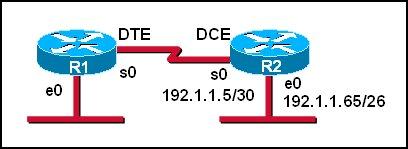
A.
R1 (config)# interface ethernet 0
R1 (config-if)# ip address 192.1.1.129 255.255.255.192
R1 (config-if)# no shutdown
B.
R1 (config)# interface ethernet 0
R1(config-if)#ip address 192.1.1.97 255.255.255.192
R1 (config-if)# no shutdown
C.
R1 (config)# interface serial 0
R1 (config-if)# ip address 192.1.1.4 255.255.255.252
R1 (config-if)# clock rate 56000
D.
R1 (config)# interface serial 0
R1(config-if)#ip address 192.1.1.6 255.255.255.252
R1 (config-it)# no shutdown
E.
R1 (config)# router rip
R1 (config-router)# network 192.1.1.4
R1 (config-router)# network 192.1.1.128
F.
R1 (config)# router rip
R1 (config-router)# version 2
R1 (config-router)# network 192.1.1.0
Answer: A D F
Explanation
First we notice that the ip address of the E0 interface of R2 is 192.1.1.65/26, which has:
+ Increment: 64 (/26 = 1111 1111.1111 1111.1111 1111.1100 0000)
+ Network address: 192.1.1.64
+ Broadcast address: 192.1.1.127
Therefore, the ip address of the E0 interface of R1 cannot belong to this range or the network cannot operate correctly.
In answer A, the ip address of E0 interface of R1 is 192.1.1.129, which does not belong in this range -> A is correct.
In answer B, E0 interface of R1 has the ip address of 192.1.1.97, which belongs in this range -> B is not correct.
The s0 interface of R1 must belong to the same network of s0 interface of R2, which has:
+ Increment: 4 (/30 = 1111 1111.1111 1111.1111 1111.1111 1100)
+ Network address: 192.1.1.4
+ Broadcast address: 192.1.1.7
The ip 192.1.1.5 has been used by s0 of R2 so the only suitable ip address of s0 of R1 is 192.1.1.6 -> C is wrong but D is correct.
Now the last thing we must do is enabling RIP. Because e0 interface of R1 and e0 interface of R2 have the same major network (192.1.1.0/24) so we must use RIP version 2 to support discontiguous network -> F is correct.
For answer E, if we configure 2 networks
R1 (config-router)# network 192.1.1.4
R1 (config-router)# network 192.1.1.128
then these networks will be automatically summarized as 192.1.1.0 network.
Question 6
Refer to the exhibit. Two routers have just been configured by a new technician. All interfaces are up. However, the routers are not sharing their routing tables. What is the problem?

A. Split horizon is preventing Router2 from receiving routing information from Router1.
B. Router1 is configured for RIP version 2, and Router2 is configured for RIP version 1.
C. Router1 has an ACL that is blocking RIP version 2.
D. There is a physical connectivity problem between Router1 and Router2.
E. Router1 is using authentication and Router2 is not.
Answer: B
Explanation
As we can see from the output, Router2 is sending v1 update and ignoring v2 update from neighbor so we can conclude Router2 is running RIPv1. Its neighbor, Router1 (ip address of 192.168.2.1), is running RIPv2.
Notice that router running RIPv2 can “understand” RIPv1 update but router running RIPv1 cannot understand RIPv2 update.
Question 7
What is the default routing update period for RIPv2?
A. 15 seconds
B. 30 Seconds
C. 180 Seconds
D. 240 Seconds
Answer: B
Question 8
Refer to the exhibit. The network manager is evaluating the efficiency of the current network design. RIPv2 is enabled on all Layer 3 devices in the network. What network devices participate in passing traffic from the PC at 10.10.1.7 to File Server at 10.20.1.6 in the order that they will forward traffic from source to destination?
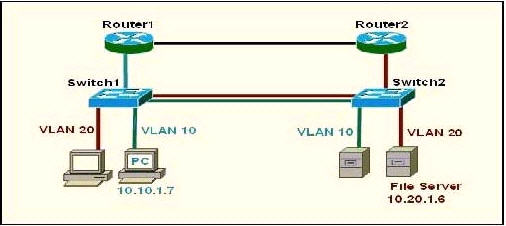
A. Switch, Switch2
B. Switch, Switch2, Router2, Switch2
C. Switch1, Router1, Switch1, Switch2
D. Switch1, Router1, Router2, Switch2
Answer: D
Explanation
The PC and File Server are in different VLANs so surely traffic from PC to File Server must go through Router1 but which path will the packet go next, through Router 2 or Switch1? Well, it is a hard question to answer.
As many comments said “the connection between R1 and Switch is Blue, so that means its under Vlan 10, and R2 to Switch 2 is red. The two routers do not have subinterfaces and are not running router on a stick basing on the color of the links” so D should be the correct answer.
Just for your information, I keep this explanation (which supports answer C) but in the exam you should choose D as your answer!
I haven’t had tested it yet but I guess that because there is a VLAN 20 on Switch 1 so Router1 will try to send that packet back to Switch1. If the link between Switch1 and Switch2 is a trunk link then the returned packet will also be sent to this link. Switch 2 receives that packet and it sends to the File Server at VLAN20. So the path will be Switch1 -> Router1 -> Switch1 -> Switch2.
There are some debates about this question but if the routers are properly configured then the packets can go from Switch1 -> Router1 -> Router2 -> Switch2 (D answer) so D can be a correct answer.
Question 9
Refer to the exhibit. Router A has interfaces with addresses 192.168.1.1 and 172.16.1.1. Router B, which is connected to router A over a serial link, has interfaces with address 172.16.1.2 and 10.1.1.2.
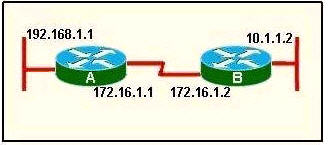
Which sequence of commands will configure RIPv2 on router B?
A.
B( config)# router rip
B(config-router)#version 2
B(config-router)# network 172.16.0.0
B(config-router)# network 10.0.0.0
B(config-router)# end
B.
B(config)# router rip 2
B(config-router)# network 172.16.0.0
B(config-router)# network 10.0.0.0
B(config-router)# end
C.
B(config)# router rip
B(config-router)#version 2
B(config-router)# network 172.16.0.0
B(config-router)#network 192.168.1.0
B(config-router)#end
D.
B(config)# router rip version 2
B(config-router)# network 172.16.0.0
B(config-router)# network 10.0.0.0
B(config-router)#end
Answer: A
Question 10
Refer to the exhibit. S0/0 on R1 is configured as a multipoint interface to communicate with R2 and R3 in this hub-and-spoke Frame Relay topology.
While testing this configuration, a technician notes that pings are successful from hosts on the 172.16.1.0/24 network to hosts on both the 172.16.2.0/25 and 172.16.2.128/25 networks. However, pings between hosts on the 172.16.2.0/25 and 172.16.2.128/25 networks are not successful. What could explain this connectivity problem?
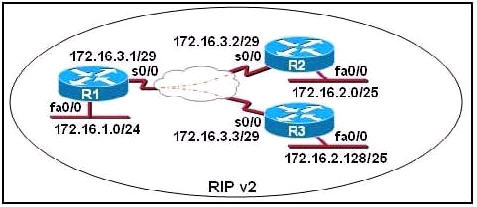
A. The ip subnet-zero command has been issued on the R1 router.
B. The RIP v2 dynamic routing protocol cannot be used across a Frame Relay network.
C. Split horizon is preventing R2 from learning about the R3 networks and R3 from learning about the R2 networks.
D. The 172.16.2.0/25 and 172.16.2.128/25 networks are overlapping networks that can be seen by R1, but not between R2 and R3.
E. The 172.16.3.0/29 network used on the Frame Relay links is creating a discontiguous network between the R2 and R3 router subnetworks.
Answer: C
Explanation
The “ip subnet-zero” allows the use of the first subnet but it doesn’t cause this problem and we don’t have that first subnet (like 172.16.0.0/24) so we can’t confirm if the “ip subnet-zero” was used or not -> A is not correct.
Frame-Relay can use RIPv2 with no problem if we configure it correctly -> B is not correct.
In the exhibit above we notice that the s0/0 interface of R1 has not been divided into sub-interfaces so the split horizon will prevent updates from R2 to R3 and vice versa. The split horizon rule states “A router never sends information about a route back in same direction which is original information came”. In this case R2 send an update to S0/0 of R1 so R1 cannot send that update back on S0/0 -> R3 will not learn about networks of R2 (and vice versa) -> C is correct.
172.16.2.0/25 and 172.16.2.128/25 networks are not overlapping networks. They are two different sub-networks -> D is not correct.
RIPv2 is a classless routing protocol so it supports VLSM and discontiguous networks -> E is not correct.
Question 11
Refer to the exhibit. After a RIP route is marked invalid on Router_1, how much time will elapse before that route is removed from the routing table?
| Router_1# show ip protocols Routing Protocol is “rip” Sending updates every 30 seconds, next due in 8 seconds Invalid after 180 seconds, hold down 180, flushed after 240 Outgoing update filter list foe all interfaces is not set Incoming update filter list for all interfaces is not set Router 1# |
A. 30 seconds
B. 60 seconds
C. 90 seconds
D. 180 seconds
E. 240 seconds
Answer: B
Explanation
The question reads: After a RIP route marked invalid on Router_1, how much time will elasped before that route is removed from the routing table.
The word “REMOVED” in the question means “FLUSHED”
Carefully look at the Router_1 show ip protocol output:
Invalid is 180 secs.
Flushed is 240secs.
RIP route marked invalid (180secs.)
Time elasped before route is removed (Flushed 240secs.)
The difference is 60secs……..240-180=60. Actually is 180+60=240.
Please notice that the invalid timer, hold down timer and flush timer start counting at the same time.
Question 12
Refer to the graphic. Host 1 cannot receive packets from Host 2. Assuming that RIP v1 is the routing protocol in use, what is wrong with the IP configuration information shown? (Choose two)
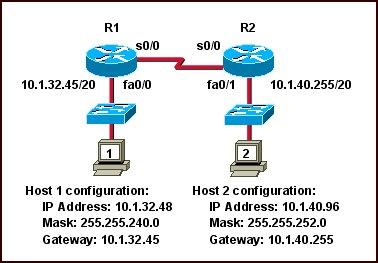
A. The fa0/1 interface of router R2 has been assigned a broadcast address.
B. The fa0/1 network on router R2 overlaps with the LAN attached to R1.
C. Host 2 has been assigned the incorrect subnet mask.
D. Host 1 has been configured with the 255.255.248.0 subnet mask.
E. Host 2 on router R2 is on a different subnet than its gateway.
Answer: B C
Explanation
The fa0/1 interface of R2 is assigned an IP address of 10.1.40.255/20. It seems to be a broadcast address but it is not. If we calculate the range of this network we will understand why:
Network 10.1.40.255/20
Increment: 16 (/20 = 1111 1111.1111 1111.1111 0000.0000 0000)
Network address: 10.1.32.0
Broadcast address: 10.1.47.255
-> 10.1.40.255/20 is an usable host address -> A is not correct.
The IP address of host 1 (10.1.32.48) belongs to the range of interface fa0/1 on R2 as shown above -> B is correct.
In the topology above, all subnet masks are /20 (255.255.240.0) excepting the subnet mask of Host 2 (255.255.252.0) so C can be incorrect.
The subnet mask of Host 1 is 255.255.240.0, not 255.255.248.0 -> D is not correct.
Host 2 is not on a different subnet than its gateway even if the subnet mask 255.255.252.0 is used. Let’s analyze the range of Host 2 network:
Network 10.1.40.96/22
Increment: 4
Network address: 10.1.40.0
Broadcast address: 10.1.43.255
Its gateway (10.1.40.255) is still belongs to this range -> E is not correct.
Note: In this question, C is the best suitable answer after eliminating A, D, E answers. But in fact Host 2 can ping its gateway because they are on the same subnet.
Question 13
What two things will a router do when running a distance vector routing protocol? (Choose two)
A. Send periodic updates regardless of topology changes.
B. Send entire routing table to all routers in the routing domain.
C. Use the shortest-path algorithm to the determine best path.
D. Update the routing table based on updates from their neighbors.
E. Maintain the topology of the entire network in its database.
Answer: A D
Question 14
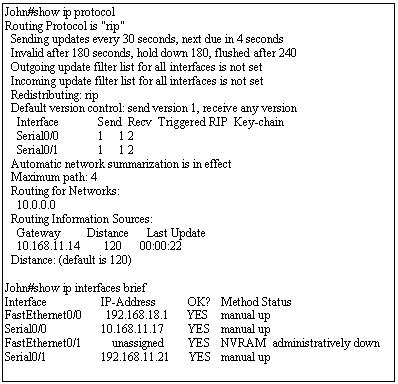
Use the output from the router shown in the graphic above to determine which of the following are correct. (Choose two)
A. Router John uses a link-state routing protocol.
B. Router John will receive routing updates on the Serial0/0 interface.
C. Router John will receive routing updates on the Serial0/1 interface.
D. Router John will send routing updates out the Serial0/0 interface.
E. Router John will send routing updates out the FastEthernet0/0 interface.
F. Router John will send routing updates out the Serial0/1 interface.
Answer: B D
Explanation
As you can see under “Routing for networks”, network “10.0.0.0″ is advertising. The IP address of S0/0 is 10.168.11.17 which belongs to 10.0.0.0 network -> RIP is running on s0/0 interface only, not s0/1 -> S0/0 will send and receive RIP updates.
Question 15
What can be determined from the line of show ip route output shown in the exhibit? (Choose two)
R 10.10.10.8 [120/2] via 10.10.10.6,00:00:25, Serial0/1
A. The next routing update can be expected in 35 seconds.
B. The IP address 10.10.10.6 is configured on S0/1.
C. The IP address 10.10.10.8 is configured on S0/1.
D. This route is using the default administrative distance.
E. The 10.10.10.8 network is two hops away from this router.
Answer: D E
Explanation
From the output, we can see 2 parameters [120/2]. The first is the administrative distance of the routing protocol being used. In this case it is RIP (symbolized by the letter “R”). Because 120 is also the default administrative distance value of RIP -> D is correct.
In RIP, the metric is hop count so “2″ means the network 10.10.10.8 is two hops (routers) away from this router.



i am plan to write CCNA exam in coming week,Please share the latest dumps or atleast confirm wheather dumps was changed or not for current exam…… dineshkumar.b.e.e.e@gmail.com
i am plan to write CCNA exam in coming week Please share the latest dumps pls
muhamedamjath@gmail.com
hi ,latest dumps
hani_2012_rad@yahoo.com
you have got an incredible phorum here! would you wish to make some invite posts on my wephorum? wish you all the best
Please send me CCNA latest dumps to jwaicekauskas@yahoo.com
Thank you.
prema
November 10th, 2012 Please answer my question?
question 6:
What I have learned from the book is V1 will send V1 update but can accept both 1 and 2.V2 can send and rx only V2.
But the above explanation is totally different.
can someone clarify this for me
Even in Q14 ,refer to the output of sh ip protocols ,it shows rip vesion 1 is sending 1 and can accept both 1 and 2
Q11 it is clearly 240 after the invalid timer see:
http://www.cisco.com/en/US/docs/ios/12_0/np1/configuration/guide/1crip.html
if no update have been received between 0 –> 180 secondes, the invalid timer starts and the route is marked as invalid. After the invalid timer count to the end, the holddown timer begin to count to 180 more seconds and 60 second after the holddown timer, if there is no update for this same route, the flush timer flushs completly this route from routing table.
SO the good answer is 240 –> E
Excuse me I am wrong here, all this 3 timers begin counting at the same time
thanks to @9tut
@9tut
Q11 the flush time is 240 seconds how come 60..explain more if it’s correct
@asif
By default, the flush timer is set for 240 seconds, which is 60 seconds longer than the invalid timer. When the flush timer expires, the route is removed from the routing table.
So the question asking how much time after the route is marked invalid…so it should be 60
@suresh @asif
Q11
By default, the flush timer is set for 240 seconds, which is 60 seconds longer than the invalid timer. When the flush timer expires, the route is removed from the routing table.
So the question asking how much time after the route is marked invalid…so it should be 60
@ Kim-no it can’t be because it doesnt send entire routing table to all routers in the routing domain it only send frequent updates to neighbor routers only.
So ans A & D are correct.
Q6:
I doubt the last statement of the answer is correct.
RIPv2 can send updates to RIPv2 and default RIP. And it can Receive updates only from RIPv2( not even from default RIP)
Q4:
why answer is not A and B?
Q14 question 14
routing protocol is RIPv1 as it sends v1 updates,
it is classful protocol, and autosumarisation is in effect,
ROUTING FOR NETWORKS = 10.0.0.0 – notice this it’s class A address with mask /8, so the ip address 10.168.11.17of s0/0 its summarised to 10.0.0.0 by RIPv1 hence s0/0 is the only interface that participate in routing update exchange
I hope I made sense :D
@sumon
as you can see v2 its being send and received, v2 means RIPv2 is enabled so it can’t be A
it can’t be B as 224.0.0.9 is special multicast address for RIPv2, used to send RIPv2 updates
http://en.wikipedia.org/wiki/Multicast_address
@sumon Q4 question 4
as you can see v2 its being send and received, v2 means RIPv2 is enabled so it can’t be A
it can’t be B as 224.0.0.9 is special multicast address for RIPv2, used to send RIPv2 updates
http://en.wikipedia.org/wiki/Multicast_address
Please provide me the last dump.
AlfonsoRamirezb21@gmail.com
TY 9tut.
Today I have passed the CCNA. (860/825)
50 questions 3 labs (VTP, EIGRP, ACL). 35 from 9tut.
Also thanks a lot Brar and Sekhar (still valid from examcollection)
Ty again 9tut
from here Q 8
What are two characteristics of RIPv2? (Choose two)
A. classful routing protocol
B. variable-length subnet masks
C. broadcast addressing
D. manual route summarization
E. uses SPF algorithm to compute path
rip v2 is auto-summarization, please check and explain me
@arun pandian, Because RIPv2 is a classless Routing protocol and this means the summarizationis controlled manually and support VLSM.
Hope this helps :)
Dear 9tut,
Is VLSM a characteristic common between RIP and EIGRP? If so, what about route summarization, and route update authentication? If not, how can this characteristics be differentiated between the two protocols?
@kevin Karl
EIGRP Supports VLSM
RIP Version 2 Supports VLSM (Rip ver 1 does not support VLSM)
Nice work 9tut. Exam due soon. Heard the update exam is by jan 12. 2013. How true
i heard that, is on 13jan,2013! is true
Q6
I think the answer B is wrong. Correct is E … or?.
Please Anyone Send Me latest CCNA Dumps My Id IS Shakernice@gmail.com
Hi.
I didnt understand answers of Q14.
Answer B is correct I’m sure. But, if router reseived update from S0/0, how could router send update to S0/0. What about split-horizon?
Serge, Split horizon says ” I dont send a route to the interface that teached me about that route”. “Gateway” is a rip neighbor, so it can send and receive updates there. It doesnt seem to be anything related to redundant information in the statement of the question.
Hi Serge if see the router use only one interface S0/0 to receive and send updates but as you know split horizon rule do not allow send updates back in the same direction where it was receive it, the only way you can do this is configuring subinterfaces.
Kim the Q13 Rip actually do ” Send entire routing table to all routers” but do not use ” routing domain” concept so it’s half true and half wrong then is wrong is a tricky question from cisco.
Q14 question can anybody tell me how to find answer pls
in Q13 , distance vector routing protocol does not send entire routing table to all routers in the routing domain,I think, it sends routing table to it’s neighbours.
in Q13 , distance vector routing protocol does not send entire routing table to all routers in the routing domain,I think, it sends routing table to it’s neighbours.
Refer to the exhibit. After a RIP route is marked invalid on Router_1, how much time will elapse before that route is removed from the routing table?
Router_1# show ip protocols
Routing Protocol is “rip”
Sending updates every 30 seconds, next due in 8 seconds
Invalid after 180 seconds, hold down 180, flushed after 240
Outgoing update filter list foe all interfaces is not set
Incoming update filter list for all interfaces is not set
Router 1#
A. 30 seconds
B. 60 seconds
C. 90 seconds
D. 180 seconds
E. 240 seconds
Answer: B
pleas review that again is confusing where did 60 come from any one…
Same as 999 doble, I’m not sure where the 60 came from, can anoyone please clarify :)
Thanks in advance!
@999, @Corsica86: We added explanation to that question, please read again.
Can anyone please send me latest dump please, my email is renojefa@gmail.com
Refer to the exhibit. After a RIP route is marked invalid on Router_1, how much time will elapse before that route is removed from the routing table?
Router_1# show ip protocols
Routing Protocol is “rip”
Sending updates every 30 seconds, next due in 8 seconds
Invalid after 180 seconds, hold down 180, flushed after 240
Outgoing update filter list foe all interfaces is not set
Incoming update filter list for all interfaces is not set
Router 1#
A. 30 seconds
B. 60 seconds
C. 90 seconds
D. 180 seconds
E. 240 seconds
Answer: B
The question says,
After a RIP route is marked invalid on Router_1, how much time will elapse before that route is removed from the routing table?
What you need to read up on is around the Count to infinity routing loops, the holddown timers are used to ensure that routing loops dont occur and the hold down timer only occurs after 180s then at 240s the bad route is flushed/deleted. Coming back to the question where it asks for the time elapsed before it gets removed. So once the holddown timer passes thats when it knows there is a bad route, then the question is asking how long does it stay in the routing table before it gets “flushed” so that is 240-180=60s
@ Remy,
Thanks a lot for sharing valueable quen n answ.-)
hey can some share latest dumps with me on usman.basharat@hotmail.com? i want to give CCNA test
dear frnds how many qs routing side pls telme
Hi everybody! :D Can someone explain me the answer of Question #4, please help me…
just eliminate everything and your only left with one. It doesn’t show anything about RIPv1 packets being ignored. The loopback interface cannot be a rip neighbor because you cant make a loopback advertise networks. I dont know thats how i did it and just eliminated that there is a loop, unless they disabled split horizion.
i dont get question 4 as well..can anyone give a detailed explanation for it please?
@ 9ut or @ all
5) i think A is not correct ,b is correct.
please confirm it.
@satheesh B is not correct because R2′s LAN network range is 192.1.1.64 to 192.1.1.127 so B would cause R1′s LAN network to overlap with R’s subnet.
/26 subnet mask = 255.255.255.192 (1111 1111.1111 1111.1111 1111.1100 0000),
which equals to an increment of 64.
R2′s
Network 192.1.1.64/26
Increment: 64 (/26 = 1111 1111.1111 1111.1111 1111.1100 0000)
Network address: 192.1.1.64
Broadcast address: 192.1.1.127
Someone can tell me where i can get more simulation qn based on eigrp…..
@Manoj: If you want to learn more about EIGRP you can go to http://www.digitalltut.com and find the EIGRP topics. Although the knowledge is for CCNP candidates but it is also good for better understanding EIGRP.
Thank you very much !!